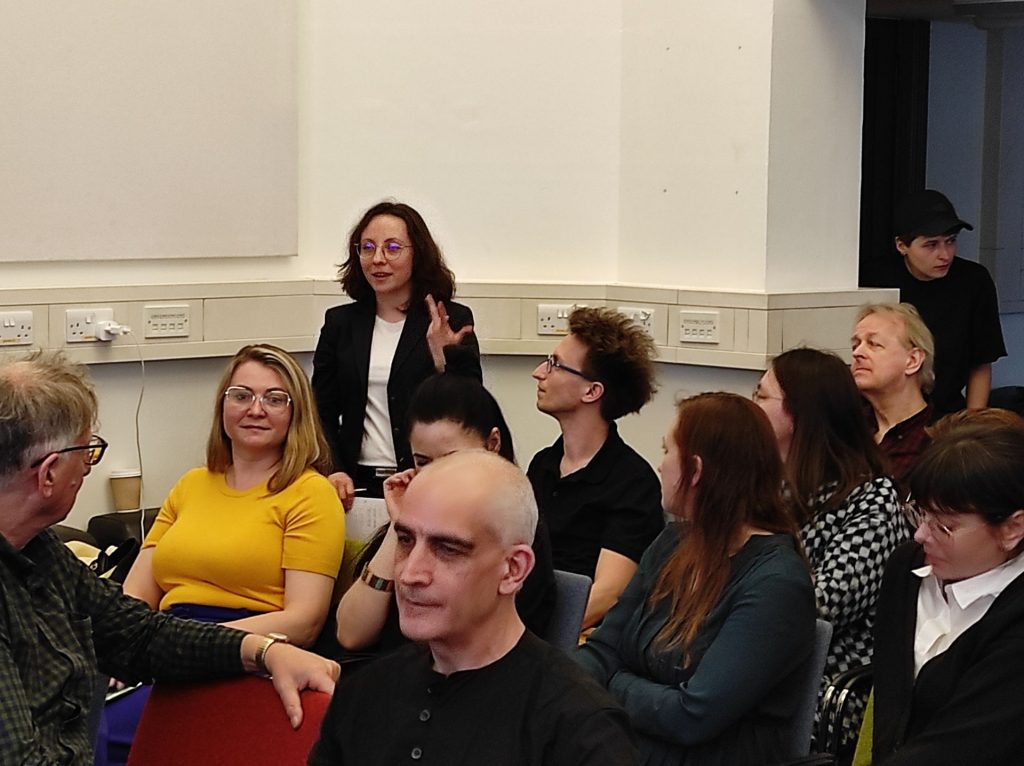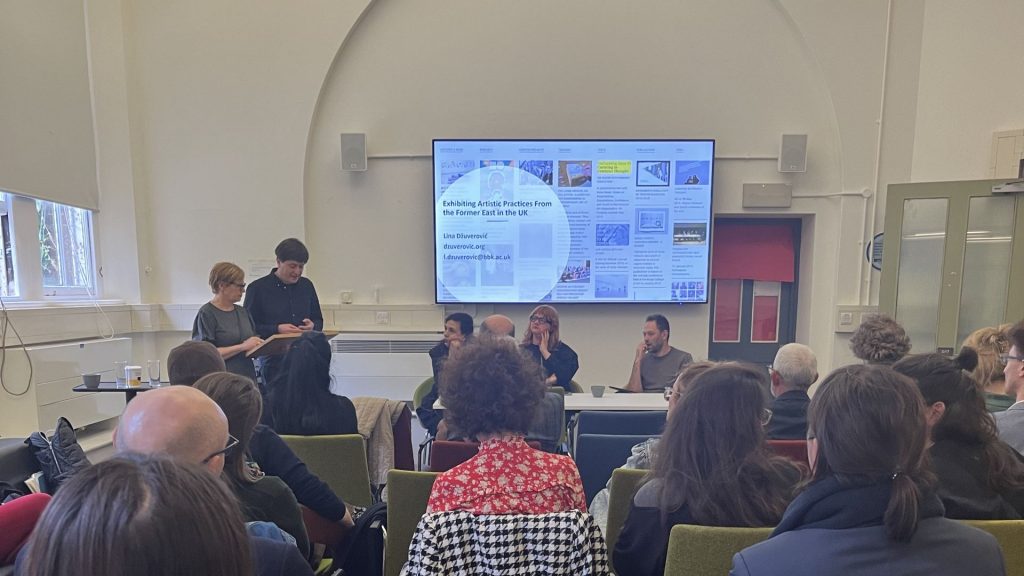The Logic of Collecting
By Maja Fowkes, on 28 August 2022
By Pavlína Morganová
![]()
 Christine Macel’s presentation was one of the public events of Confrontations sessions in London. This well attended guest lecture at UCL’s Institute of Advanced Studies was a great opportunity to meet the chief curator of the Centre George Pompidou and director of 2017 Venice Biennale. Macel talked openly about the museum’s collections and the works which represent art from Eastern and Central Europe. She revealed some of the strategies, but also frustrations, connected to the acquisitions process. She even showed a list of artists, which the museum is targeting. One could read names, such as Milan Grygar, Karel Malich, Václav Boštík, Vjencislav Richter, Goran Trbuljak, Stano Filko, Milan Knížák, Katalin Ladik, Anna Kutera, Ewa Partum, Jarosław Kozłowski, Endre Tót, Tamás Szentjoby, Maria Pinińska-Bereś, Mirosław Bałka, Katarzyna Kozyra, Milica Tomić or IRWIN. (Pavlína Morganová)
Christine Macel’s presentation was one of the public events of Confrontations sessions in London. This well attended guest lecture at UCL’s Institute of Advanced Studies was a great opportunity to meet the chief curator of the Centre George Pompidou and director of 2017 Venice Biennale. Macel talked openly about the museum’s collections and the works which represent art from Eastern and Central Europe. She revealed some of the strategies, but also frustrations, connected to the acquisitions process. She even showed a list of artists, which the museum is targeting. One could read names, such as Milan Grygar, Karel Malich, Václav Boštík, Vjencislav Richter, Goran Trbuljak, Stano Filko, Milan Knížák, Katalin Ladik, Anna Kutera, Ewa Partum, Jarosław Kozłowski, Endre Tót, Tamás Szentjoby, Maria Pinińska-Bereś, Mirosław Bałka, Katarzyna Kozyra, Milica Tomić or IRWIN. (Pavlína Morganová)
 Responding to Macel, Professor Briony Fer from UCL questioned the role and agency of art museums in a cultural sphere that is ultimately shaped by geopolitics and market forces. Although the collecting strategies towards Eastern Europe of the two institutions were not directly confronted during the presentations, there was a sense that Tate Modern pursues a more systematic and rigorous approach, relying on an infrastructure of advisory committees, while the Pompidou is more ad hoc but potentially faster moving in responding to the changing art historical landscape of the region.
Responding to Macel, Professor Briony Fer from UCL questioned the role and agency of art museums in a cultural sphere that is ultimately shaped by geopolitics and market forces. Although the collecting strategies towards Eastern Europe of the two institutions were not directly confronted during the presentations, there was a sense that Tate Modern pursues a more systematic and rigorous approach, relying on an infrastructure of advisory committees, while the Pompidou is more ad hoc but potentially faster moving in responding to the changing art historical landscape of the region.
 Contributions from the floor also raised issues around the implications of the war in Ukraine for curatorial and collecting policies towards a region that is undergoing geopolitical redefinition. Members of the Confrontations group tested the boundaries of the expansion of institutional collecting by asking whether there is or would ever be room for works of socialist realism in the collection displays of the history of modern art. The discussion broached further questions around the comparison of the general state of research into East European art in the United Kingdom and France, and the extent to which academic and museological structures are conducive to research into the art of the region. (Maja & Reuben Fowkes)
Contributions from the floor also raised issues around the implications of the war in Ukraine for curatorial and collecting policies towards a region that is undergoing geopolitical redefinition. Members of the Confrontations group tested the boundaries of the expansion of institutional collecting by asking whether there is or would ever be room for works of socialist realism in the collection displays of the history of modern art. The discussion broached further questions around the comparison of the general state of research into East European art in the United Kingdom and France, and the extent to which academic and museological structures are conducive to research into the art of the region. (Maja & Reuben Fowkes)

 Close
Close


 The presentation by Katarzyna Murawska-Muthesius, lecturer at Birkbeck and author of Imaging and Mapping Eastern Europe, took the form of a personal perspective on the evolution of academic interest in East European art in the UK. Rare archival images of conferences and gatherings of researchers on the region dating back to the pre-digital era of the mid-1990s underlined the embodied quality of exchanges amongst members of the informal network of scholars of Central and Eastern European art, and were reminders of the loss of colleagues such as Piotr Piotrowski. The title of Kasia presentation was she explained a partial corrective to the tendency to constantly enumerate how much work still needs to be done in terms of research into specific artists, as well as in asserting the position of our region in wider narratives and debates. She chose to focus instead on everything that has already been achieved, from scholarly publications and exhibition history to the activity of research networks such as Confrontations, in deepening knowledge and understanding of East European art.
The presentation by Katarzyna Murawska-Muthesius, lecturer at Birkbeck and author of Imaging and Mapping Eastern Europe, took the form of a personal perspective on the evolution of academic interest in East European art in the UK. Rare archival images of conferences and gatherings of researchers on the region dating back to the pre-digital era of the mid-1990s underlined the embodied quality of exchanges amongst members of the informal network of scholars of Central and Eastern European art, and were reminders of the loss of colleagues such as Piotr Piotrowski. The title of Kasia presentation was she explained a partial corrective to the tendency to constantly enumerate how much work still needs to be done in terms of research into specific artists, as well as in asserting the position of our region in wider narratives and debates. She chose to focus instead on everything that has already been achieved, from scholarly publications and exhibition history to the activity of research networks such as Confrontations, in deepening knowledge and understanding of East European art. The public panel on East European Art in the UK saw insightful presentations by UK-based curators, academics and institution builders with close ties to the region. Lina Džuverović reflected on the challenges she faced as a curator at Calvert22 in the early Twenty-Teens in bringing the work of prominent East European artists, including Sanja Iveković and IRWIN, to London audiences.
The public panel on East European Art in the UK saw insightful presentations by UK-based curators, academics and institution builders with close ties to the region. Lina Džuverović reflected on the challenges she faced as a curator at Calvert22 in the early Twenty-Teens in bringing the work of prominent East European artists, including Sanja Iveković and IRWIN, to London audiences. Alicja Kaczmarek, founder and director of Centrala Space, a cultural organisation based in Birmingham that provides a platform for artists from the region, presented the results of the In-between Spaces research project into the Inclusion and Representation of Central and East European artists in the UK Creative Economy. Among the key findings she shared was that artists from the region are underrepresented in art galleries, exhibitions and festivals, in comparison to artists from Western Europe and North America, and that as migrants from Eastern Europe they experience a complex form of racialisation in the UK based on negative media portrayals. Vlad Morariu spoke about the Collection Collective, of which he is a member, and its speculative exploration of the possibility to short-circuit the structure of the art market by constructing a contemporary art collection that is owned and managed collectively by its members.
Alicja Kaczmarek, founder and director of Centrala Space, a cultural organisation based in Birmingham that provides a platform for artists from the region, presented the results of the In-between Spaces research project into the Inclusion and Representation of Central and East European artists in the UK Creative Economy. Among the key findings she shared was that artists from the region are underrepresented in art galleries, exhibitions and festivals, in comparison to artists from Western Europe and North America, and that as migrants from Eastern Europe they experience a complex form of racialisation in the UK based on negative media portrayals. Vlad Morariu spoke about the Collection Collective, of which he is a member, and its speculative exploration of the possibility to short-circuit the structure of the art market by constructing a contemporary art collection that is owned and managed collectively by its members. The panel discussion underlined the overlap between issues around the representation of the region in art historical and museum accounts and the everyday challenges faced by East European artists in gaining visibility in the UK artworld. It also demonstrated the existence of a transnational community of scholars, curators and artists, who through their work and acts of solidarity, continue to raise the profile of East European art and artists across global geographies.
The panel discussion underlined the overlap between issues around the representation of the region in art historical and museum accounts and the everyday challenges faced by East European artists in gaining visibility in the UK artworld. It also demonstrated the existence of a transnational community of scholars, curators and artists, who through their work and acts of solidarity, continue to raise the profile of East European art and artists across global geographies.